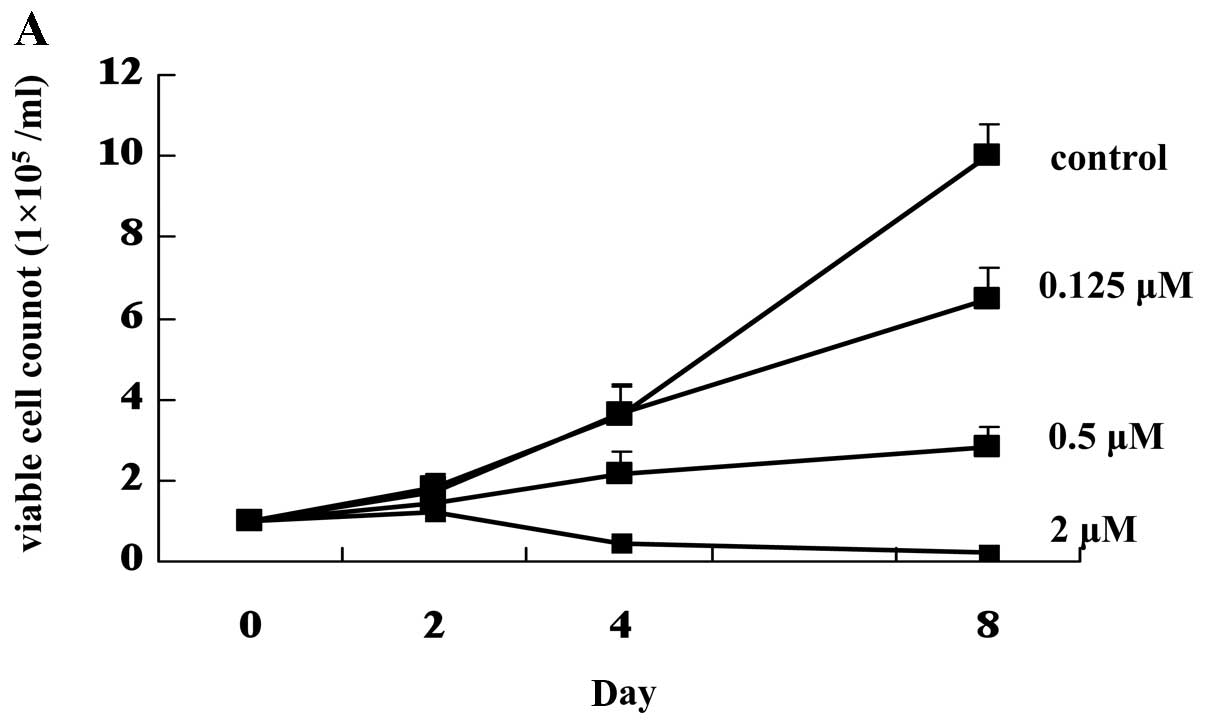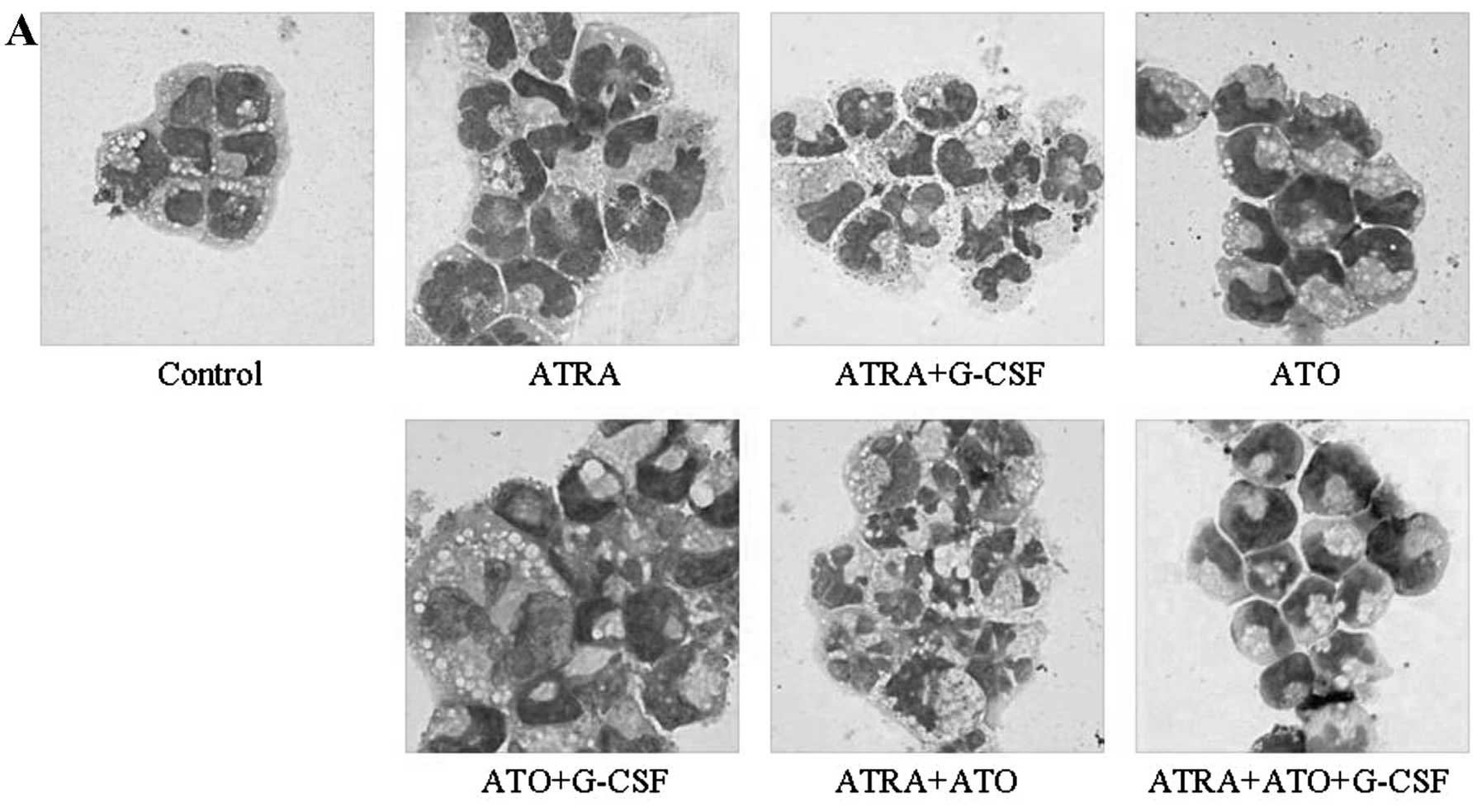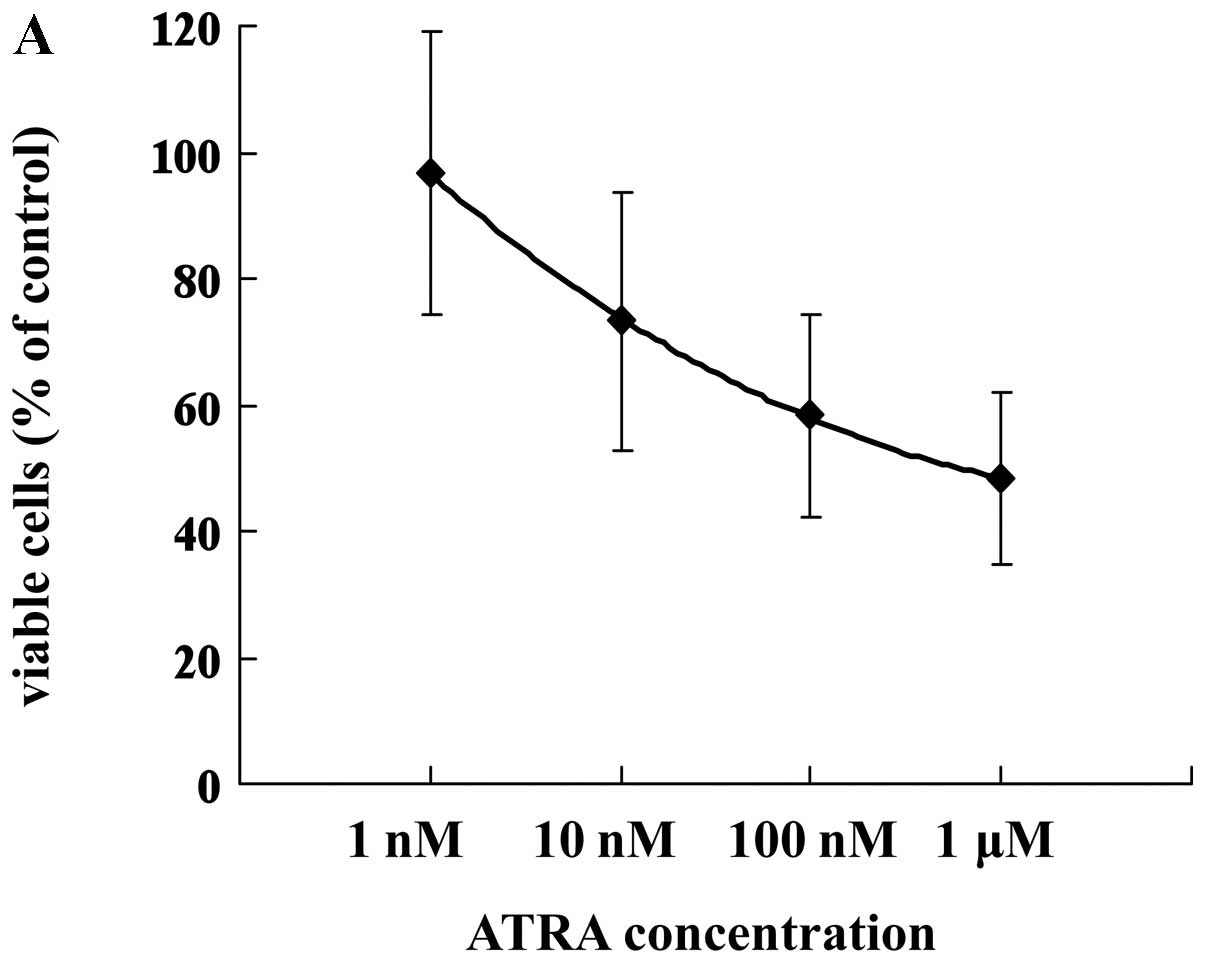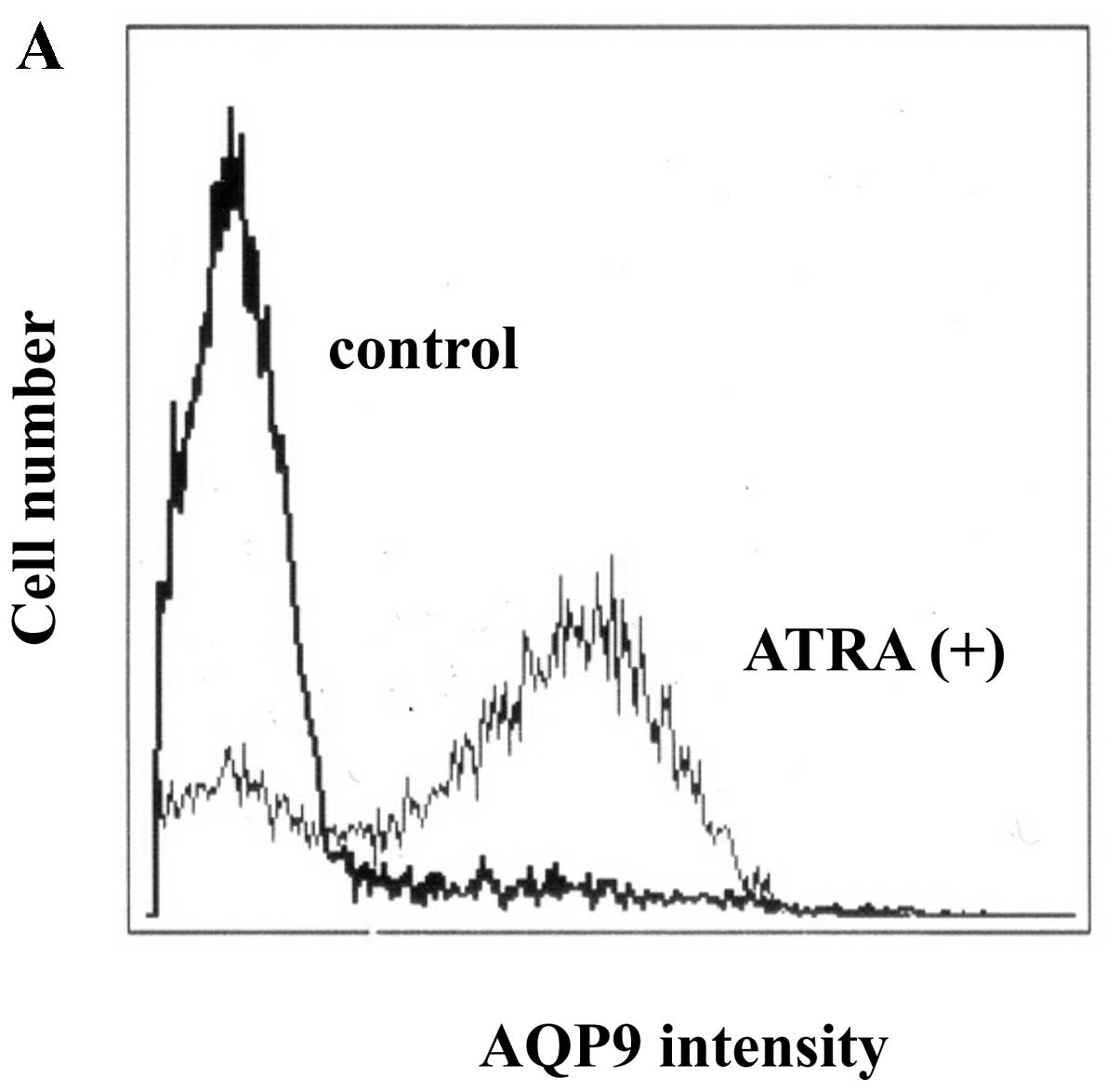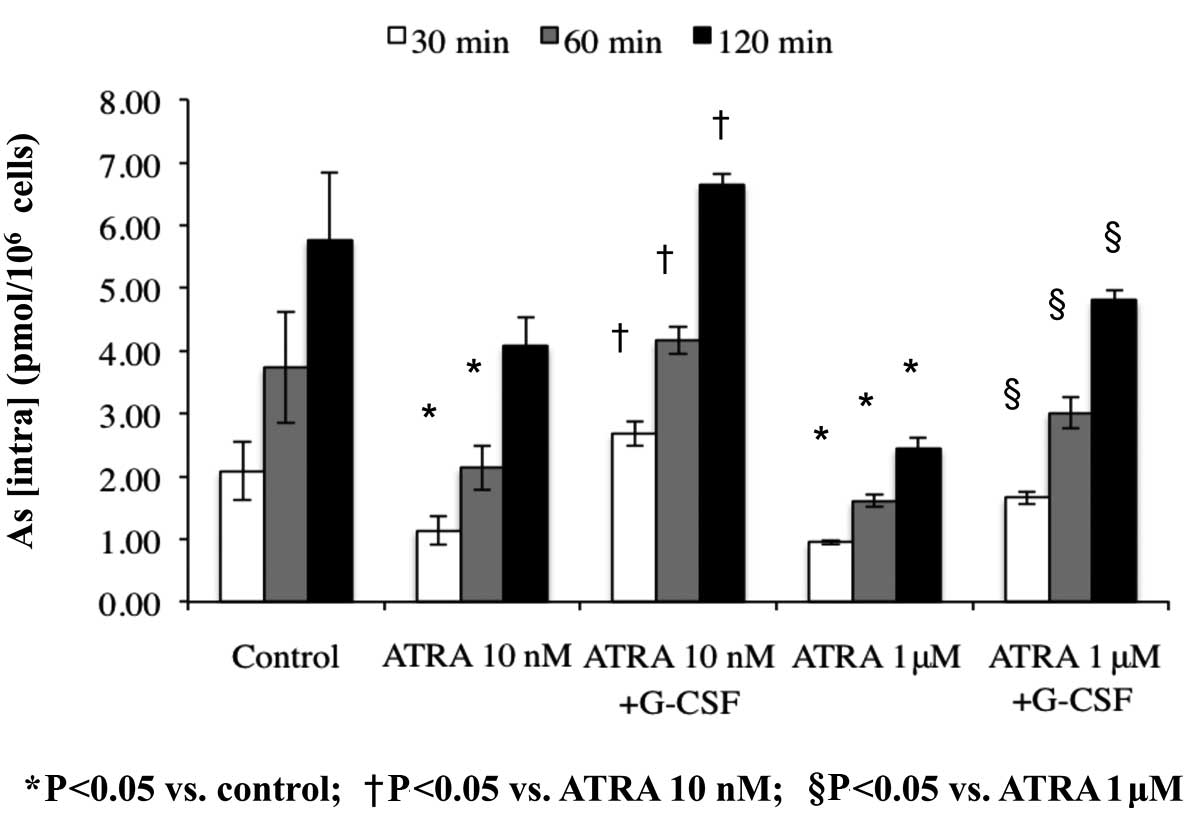|
1
|
Goddard AD, Borrow J, Freemont PS and
Solomon E: Characterization of a zinc finger gene disrupted by the
t(15;17) in acute promyelocytic leukemia. Science. 254:1371–1374.
1991. View Article : Google Scholar : PubMed/NCBI
|
|
2
|
Tong JH, Dong S, Geng JP, Huang W, Wang
ZY, Sun GL, Chen SJ, Chen Z, Larsen CJ and Berger R: Molecular
rearrangements of the MYL gene in acute promyelocytic leukemia
(APL, M3) define a breakpoint cluster region as well as some
molecular variants. Oncogene. 7:311–316. 1992.PubMed/NCBI
|
|
3
|
de Thé H, Chomienne C, Lanotte M, Degos L
and Dejean A: The t(15;17) translocation of acute promyelocytic
leukaemia fuses the retinoic acid receptor alpha gene to a novel
transcribed locus. Nature. 347:558–561. 1990.PubMed/NCBI
|
|
4
|
Melnick A and Licht JD: Deconstructing a
disease: RARα, its fusion partners, and their roles in the
pathogenesis of acute promyelocytic leukemia. Blood. 93:3167–3215.
1999.
|
|
5
|
Burnett AK, Grimwade D, Solomon E,
Wheatley K and Goldstone AH: Presenting white blood cell count and
kinetics of molecular remission predict prognosis in acute
promyelocytic leukemia treated with all-trans retinoic acid:
result of the Randomized MRC Trial. Blood. 93:4131–4143.
1999.PubMed/NCBI
|
|
6
|
Shen ZX, Chen GQ, Ni JH, Li XS, Xiong SM,
Qiu QY, Zhu J, Tang W, Sun GL, Yang KQ, et al: Use of arsenic
trioxide (As2O3) in the treatment of acute
promyelocytic leukemia (APL): II. Clinical efficacy and
pharmacokinetics in relapsed patients. Blood. 89:3354–3360.
1997.PubMed/NCBI
|
|
7
|
Soignet SL, Maslak P, Wang ZG, Jhanwar S,
Calleja E, Dardashti LJ, Corso D, DeBlasio A, Gabrilove J,
Scheinberg DA, et al: Complete remission after treatment of acute
promyelocytic leukemia with arsenic trioxide. N Engl J Med.
339:1341–1348. 1998. View Article : Google Scholar : PubMed/NCBI
|
|
8
|
Lanotte M, Martin-Thouvenin V, Najman S,
Balerini P, Valensi F and Berger R: NB4, a maturation inducible
cell line with t(15;17) marker isolated from a human acute
promyelocytic leukemia (M3). Blood. 77:1080–1086. 1991.PubMed/NCBI
|
|
9
|
Matsui W, Smith BD, Vala M, Beal N, Huff
CA, Diehl LF and Jones RJ: Requirement for myeloid growth factors
in the differentiation of acute promyelocytic leukaemia. Br J
Haematol. 128:853–862. 2005. View Article : Google Scholar : PubMed/NCBI
|
|
10
|
Caprodossi S, Pedinotti M, Amantini C,
Santoni G, Minucci S, Pelicci PG and Fanelli M: Differentiation
response of acute promyelocytic leukemia cells and PML/RARα
leukemogenic activity studies by real-time RT-PCR. Mol Biotechnol.
30:231–238. 2005.
|
|
11
|
Cunha De Santis G, Tamarozzi MB, Sousa RB,
Moreno SE, Secco D, Garcia AB, Lima AS, Faccioli LH, Falcão RP,
Cunha FQ and Rego EM: Adhesion molecules and Differentiation
Syndrome: phenotypic and functional analysis of the effect of ATRA,
As2O3, phenylbutyrate, and G-CSF in acute
promyelocytic leukemia. Haematologica. 92:1615–1622.
2007.PubMed/NCBI
|
|
12
|
Leung J, Pang A, Yuen WH, Kwong YL and Tse
EW: Relationship of expression of aquaglyceroporin 9 with arsenic
uptake and sensitivity in leukemia cells. Blood. 109:740–746. 2007.
View Article : Google Scholar : PubMed/NCBI
|
|
13
|
Chen GQ, Shi XG, Tang W, Xiong SM, Zhu J,
Cai X, Han ZG, Ni JH, Shi GY, Jia PM, et al: Use of arsenic
trioxide (As2O3) in the treatment of acute
promyelocytic leukemia (APL): I. As2O3 exerts
dose-dependent dual effects on APL cells. Blood. 89:3345–3353.
1997.PubMed/NCBI
|
|
14
|
Chen GQ, Zhu J, Shi XG, Ni JH, Zhong HJ,
Si GY, Jin XL, Tang W, Li XS, Xong SM, et al: In vitro studies on
cellular and molecular mechanisms of arsenic trioxide
(As2O3) in the treatment of acute
promyelocytic leukemia: As2O3 induces
NB4 cell apoptosis with downregulation of Bcl-2
expression and modulation of PML-RARα/PML proteins. Blood.
88:1052–1061. 1996.PubMed/NCBI
|
|
15
|
Yoshino Y, Yuan B, Kaise T, Takeichi M,
Tanaka S, Hirano T, Kroetz DL and Toyoda H: Contribution of
aquaporin 9 and multidrug resistance-associated protein 2 to
differential sensitivity to arsenite between primary cultured
chorion and amnion cells prepared from human fetal membranes.
Toxicol Appl Pharmacol. 257:198–208. 2011. View Article : Google Scholar
|
|
16
|
Pébusque MJ, Lafage M, Lopez M and Mannoni
P: Preferential response of acute myeloid leukemias with
translocation involving chromosome 17 to human recombinant
granulocyte colony-stimulating factor. Blood. 72:257–265. 1998.
|
|
17
|
Souza LM, Boone TC, Gabrilove J, Lai PH,
Zsebo KM, Murdock DC, Chazin VR, Bruszewski J, Lu H, Chen KK, et
al: Recombinant human granulocyte colony-stimulating factor:
effects on normal and leukemic myeloid cells. Science. 232:61–65.
1986. View Article : Google Scholar : PubMed/NCBI
|
|
18
|
Hu J, Liu YF, Wu CF, Xu F, Shen ZX, Zhu
YM, Li JM, Tang W, Zhao WL, Wu W, et al: Long-term efficacy and
safety of all-trans retinoic acid/arsenic trioxide-based
therapy in newly diagnosed acute promyelocytic leukemia. Proc Natl
Acad Sci USA. 106:3342–3347. 2009.PubMed/NCBI
|
|
19
|
Wang H, Chen XY, Wang BS, Rong ZX, Qi H
and Chen HZ: The efficacy and safety of arsenic trioxide with or
without all-trans retinoic acid for the treatment of acute
promyelocytic leukemia: a meta-analysis. Leuk Res. 35:1170–1177.
2011. View Article : Google Scholar : PubMed/NCBI
|
|
20
|
Kishi K, Toba K, Azegami T, Tsukada N,
Uesugi Y, Masuko M, Niwano H, Hashimoto S, Sakaue M, Furukawa T, et
al: Hematopoietic cytokine-dependent differentiation to eosinophils
and neutrophils in a newly established acute promyelocytic leukemia
cell line with t(15;17). Exp Hematol. 26:135–142. 1998.PubMed/NCBI
|
|
21
|
Iijima Y, Ito T, Oikawa T, Eguchi M,
Eguchi-Ishimae M, Kamada N, Kishi K, Asano S, Sakaki Y and Sato Y:
A new ETV6/TEL partner gene, ARG (ABL-related gene or ABL2),
identified in an AML-M3 cell line with a t(1;12)(q25;p13)
translocation. Blood. 95:2126–2131. 2000.PubMed/NCBI
|
|
22
|
Makishima M, Umesono K, Shudo K, Naoe T,
Kishi K and Honma Y: Induction of differentiation in acute
promyelocytic leukemia cells by 9-cis retinoic acid
alpha-tocopherol ester (9-cis tretinoin tocoferil). Blood.
91:4715–4726. 1998.PubMed/NCBI
|
|
23
|
Uesugi Y, Fuse I, Toba K, Kishi K,
Furukawa T, Koike T and Aizawa Y: Involvement of SHP-1, a
phosphotyrosine phosphatase, during myeloid cell differentiation in
acute promyelocytic leukemia cell lines. Eur J Haematol.
62:239–245. 1999. View Article : Google Scholar : PubMed/NCBI
|
|
24
|
Yoshino Y, Yuan B, Miyashita SI, Iriyama
N, Horikoshi A, Shikino O, Toyoda H and Kaise T: Speciation of
arsenic trioxide metabolites in blood cells and plasma of a patient
with acute promyelocytic leukemia. Anal Bioanal Chem. 393:689–697.
2009. View Article : Google Scholar : PubMed/NCBI
|
|
25
|
Iriyama N, Yoshino Y, Yuan B, Horikoshi A,
Hirabayashi Y, Hatta Y, Toyoda H and Takeuchi J: Speciation of
arsenic trioxide metabolites in peripheral blood and bone marrow
from an acute promyelocytic leukemia patient. J Hematol Oncol.
5:1–11. 2012. View Article : Google Scholar : PubMed/NCBI
|
|
26
|
Shao W, Fanelli M, Ferrara FF, Riccioni R,
Rosenauer A, Davison K, Lamph WW, Waxman S, Pelicci PG, Lo Coco F,
et al: Arsenic trioxide as an inducer of apoptosis and loss of
PML/RARα protein in acute promyelocytic leukemia cells. J Natl
Cancer Inst. 90:124–133. 1998.PubMed/NCBI
|
|
27
|
Wang X, Gao P, Long M, Lin F, Wei JX, Ren
JH, Yan L, He T, Han Y and Zhang HZ: Essential role of cell cycle
regulatory genes p21 and p27 expression in inhibition of breast
cancer cells by arsenic trioxide. Med Oncol. 28:1225–1254. 2011.
View Article : Google Scholar : PubMed/NCBI
|
|
28
|
Higuchi T, Kizaki M and Omine M: Induction
of differentiation of retinoic acid-resistant acute promyelocytic
leukemia cells by the combination of all-trans retinoic acid
and granulocyte colony-stimulating factor. Leuk Res. 28:525–532.
2004. View Article : Google Scholar : PubMed/NCBI
|
|
29
|
Jansen JH, de Ridder MC, Geertsma WM,
Erpelinck CA, van Lom K, Smit EM, Slater R, vd Reijden BA, de Greef
GE, Sonneveld P and Löwenberg B: Complete remission of t(11;17)
positive acute promyelocytic leukemia induced by all-trans
retinoic acid and granulocyte colony-stimulating factor. Blood.
94:39–45. 1999.PubMed/NCBI
|
|
30
|
Tsurumi H, Tojo A, Takahashi T, Moriwaki
H, Asano S and Muto Y: The combined effects of all-trans
retinoic acid and granulocyte colony-stimulating factor as a
differentiation induction therapy for acute promyelocytic leukemia.
Intern Med. 32:648–650. 1993.
|
|
31
|
Gianní M, Terao M, Zanotta S, Barbui T,
Rambaldi A and Garattini E: Retinoic acid and granulocyte
colony-stimulating factor synergistically induce leukocyte alkaline
phosphatase in acute promyelocytic leukemia cells. Blood.
83:1909–1921. 1994.
|
|
32
|
Dai CW, Zhang GS, Shen JK, Zheng WL, Pei
MF, Xu YX, Cao YX, Yi Y, Yang JJ, Peng HL, et al: Use of
all-trans retinoic acid in combination with arsenic trioxide
for remission induction in patients with newly diagnosed acute
promyelocytic leukemia and for consolidation/maintenance in CR
patients. Acta Haematol. 121:1–8. 2009.
|
|
33
|
Shinkai Y, Sumi D, Toyama T, Kaji T and
Kumagai Y: Role of aquaporin 9 in cellular accumulation of arsenic
and its cytotoxicity in primary mouse hepatocytes. Toxicol Appl
Pharmacol. 237:232–236. 2009. View Article : Google Scholar : PubMed/NCBI
|
|
34
|
Bhattacharjee H, Carbrey J, Rosen BP and
Mukhopadhyay R: Drug uptake and pharmacological modulation of drug
sensitivity in leukemia by AQP9. Biochem Biophys Res Commun.
322:836–841. 2004. View Article : Google Scholar : PubMed/NCBI
|
|
35
|
Jing Y, Wang L, Xia L, Chen GQ, Chen Z,
Miller WH and Waxman S: Combined effect of all-trans
retinoic acid and arsenic trioxide in acute promyelocytic leukemia
cells in vitro and in vivo. Blood. 97:264–269. 2001.PubMed/NCBI
|















